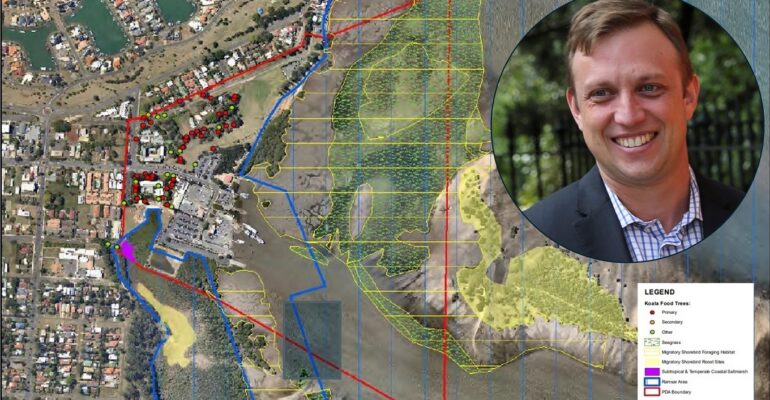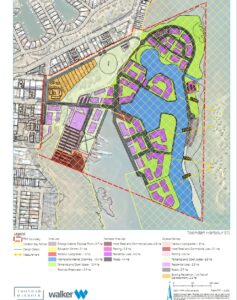
Premier Steven Miles, when Queensland’s Environment Minister, personally signed a letter to the Federal Government acknowledging an important international obligation with particular relevance to Cleveland’s Toondah Harbour real estate scheme.

Miles accepted that Australia has an obligation not to delete or restrict boundaries of a Ramsar site unless there are “urgent national interests”.
In a separate letter to the Federal Government, the Director-General of Miles’ then department accepted that the Toondah scheme would restrict boundaries of the Moreton Bay Ramsar site and so the urgent national interests test would apply (more details below).
Not surprisingly, a real estate development proposal has never satisfied this stringent test – anywhere in the world. The Ramsar Convention on Wetlands has been signed by over 170 nations, including Australia.
Walker Group’s Final EIS
In its Final Environmental Impact Statement (EIS), the Walker Group/Corporation (Walker) completely ignores the important obligation accepted by Steven Miles and his former Director-General. Curiously, Walker wants the Federal Government to ignore it too.
The EIS finally was given to Federal Environment Minister Tanya Plibersek in late November.
Walker wants to build 3,600 high-rise apartments, commercial premises and marinas, near the Stradbroke ferry terminal. Over 40 hectares of Ramsar protected wetlands would be destroyed and converted to private use and profit.
However, Walker’s own consultants have reported in the EIS that these tidal wetlands have substantial seagrass covering and are inhabited by many marine and shorebird species, including the critically endangered Eastern Curlew, which forages here.
The consultants also admit there are important migratory shorebird roosting sites nearby – at Cassim Island, Oyster Point, and Nandeebie Claypan.
Ramsar obligation acknowledged by Miles

Article 2.5 of the Ramsar Convention relevantly states:
“Any Contracting Party shall have the right to add to the List further wetlands situated within its territory, to extend the boundaries of those wetlands already included by it in the List, or, because of its urgent national interests, to delete or restrict the boundaries of wetlands already included by it in the List” (my underlining).
The restriction of Ramsar site boundaries which would result from the Toondah scheme can be seen in the image above, extracted from the final EIS (the Ramsar site boundary is yellow). The development footprint sits inside (and over) boundaries of the Moreton Bay Ramsar site. (Walker’s red herring is its claim that the plan is ‘wise use’ of the wetlands!)
The Miles’ letter was released under FOI laws. It was in response to a letter from former Federal Environment Minister, Josh Frydenberg, about the Article 2.5 obligation, and its relevance to the Toondah scheme. Fydenberg also stated that he could not act inconsistently with Australia’s Ramsar obligations.
In that respect, Frydenberg’s letter was consistent with legal advice from senior lawyers within the Federal Attorney-General’s office obtained by the ABC and canvassed in its Background Briefing report. But Frydenberg did not act on his Department’s advice to declare the Toondah scheme “clearly unacceptable”.
The Frydenberg/Miles letters are discussed in more detail in my previous article on the fatal flaw in the Toondah proposal.
Point Lillias and the toxic fire
Australian Governments previously have had no difficulty accepting that we have a binding obligation not to delete or restrict Ramsar site boundaries unless for urgent national interests.
According to Departmental advice to Frydenberg, revealed by the ABC, there has been one instance only of the Federal Government planning to invoke Article 2.5. But the plan did not proceed.
In March 1997, the Howard Government accepted a submission from the Victorian Kennett Government that it was in our urgent national interests to move a chemical storage plant from Coode Island, Melbourne to inside boundaries of the Port Phillip Bay (Western Shoreline) and Bellarine Peninsula Ramsar Site.
The planned relocation followed a toxic fire which put at risk the health of Melbourne residents. The proposal involved the excise of 20 hectares of the Ramsar site.
It was accepted by all levels of government that moving the plant to Point Lillias would have resulted in Ramsar site boundaries being deleted or restricted and so there had to be compliance with Article 2.5.
The Howard Government decision accepting the Victorian Government’s ‘urgent national interests’ argument was questioned and examined closely in the Federal Senate and elsewhere by community and environment groups. Holes in the argument emerged.
While it might have been generally accepted that moving the plant for public safety was in our urgent national interests, logically the argument had to go further. It had to be established that it was necessary to move the plant to inside a Ramsar site.
In the face of growing public opposition, the Victorian Government changed its mind and cancelled the plan in June, 1997 “because of environmental and Aboriginal heritage issues”.
Following safety improvements, the plant remained in Melbourne and the Ramsar site remained intact.
No urgent national interests
When Steven Miles was Environment Minister, there was an unsuccessful attempt by his Department’s Director-General, in the letter referred to earlier, to persuade the Federal Government the Toondah scheme was in our urgent national interests.
The letter was written on behalf of then Deputy Premier Jackie Trad and Steven Miles. The letter accepted the obvious – the proposed development would restrict Ramsar site boundaries. Article 2.5 therefore would apply.
The letter’s “urgent national interests” argument centred largely around perceived needs related to the economic impacts of ending sand mining on North Stradbroke Island in 2019. Unsurprisingly, the argument was not accepted by the Federal Government and time has exposed the Stradbroke myths which the letter relied upon.
As mentioned, Walker’s EIS does not contain any argument that its scheme is in Australia’s urgent national interests.
Walker’s glaring omission conflicts with the Federal Government’s EIS Guidelines, which required the EIS to “describe how the proposed development will not be inconsistent with Australia’s obligations”, under the Ramsar Convention.
No shortage of land
In Australia, there is no shortage of land. We have a vast land mass, unlike Singapore or Hong Kong, where it has been thought necessary to reclaim the sea to build on.
In fact, there is land behind the Stradbroke ferry terminal which was set aside for development by a previous Council.
In 2011 the Council purchased a large area of land previously owned by the CSIRO, which extends the publicly owned land to the west of the ferry terminals. It would not take 15 to 20 years to build on this land, if it was considered necessary.
Disingenuous claims of precedents
There are no previous decisions in Australia to allow a real estate development inside boundaries of a healthy Ramsar site inhabited by marine and migratory shorebird species. Walker’s EIS claims that there are Australian precedents are disingenuous.
Three of the so-called Australian precedents relate to privately owned land. In two instances, the land had been used for agricultural purposes. Neither was inhabited by migratory shorebirds. Another involved a completely degraded, pre-existing development site. And the remaining two involved approval of navigation channels through Ramsar sites, but no development inside Ramsar site boundaries.
Conclusion
There is no rational “urgent national interests” argument which could justify the Toondah Harbour scheme’s restriction of Ramsar site boundaries. This explains why Walker ignores Australia’s Article 2.5 obligation in its EIS.
There is nothing which requires the filling in and “development” of protected wetlands. There is nothing to stop the ferry terminals being upgraded in a normal manner. They lie outside the Ramsar boundaries. The Walker scheme is about building high-end, expensive apartments with Bay views – and making extremely large profits.
There has been no previous instance of the Australian Government invoking Article 2.5 to delete or restrict Ramsar site boundaries.
Subsequent to the Point Lillias case, the EPBC Act came into effect. While weak in other respects, the Act strongly reinforces Australia’s Ramsar Convention obligations.
In making her decision on the Toondah Harbour proposal, Minister Plibersek “..must not act inconsistently with Australia’s obligations under the Ramsar Convention”.
There are many reasons for Federal Environment Minister Tanya Plibersek to reject the Walker scheme, including very strong environmental ones. These reasons are independently supported by the specific obligation in Article 2.5. The proposal seeks to restrict Ramsar site boundaries for private profit, not urgent national interests.
Australia’s Article 2.5 obligation was accepted as binding by the Howard and Kennett Governments in the Point Lillias case. And, in relation to Toondah Harbour, it has been accepted as binding by the Morrison Government and by Steven Miles.
It would be very strange if Tanya Plibersek and the Albanese Government sided with Walker Corporation and chose to ignore this obligation and the Minister’s duty, when making a decision, not to act inconsistently with it.
A decision on Walker’s scheme is now due by 23 April, 2024, following an extension of the Minister’s decision making period.
Richard Carew (retired environmental lawyer)
Stradbroke (Terrangeri) Environmental and Cultural Protection Association Inc.
Redlands2030 – 22 December 2023
Please note: Offensive or off-topic comments will be deleted. If offended by any published comment please email thereporter@redlands2030.net
5 Comments
As an Australian marine biologist with a PhD carried out in Moreton Bay and 14 new species discovered and described from Moreton Bay I can confirm that it is not in Australia’s urgent National Interest to dredge and destroy the shore-bird zone at Toondah Harbour so that a wealthy developer can construct blocks of units, 3,600 units, in order to make huge profits from the intertidal zone. If this were allowed it would go down as a disgrace in the history of the region. The fact that a previous Federal Environment Minister by the name of Josh Frydenberg allowed himself to be influenced by politicians such as Andrew Laming, has not been forgotten.. We need politicians who act in the national interest rather than in the interests of developers.
The insidious proposed Toondah Harbour development, would unequivocally be an environmental CRIME! Even Sir David Attenborough has heavily condemned it.
Thank you Richard Carew.
I hope that a wise decision will now be made to protect this important environment.
Definitely no Walker development of Toondah Harbour should be allowed.
As a redlands resident for nearly 23 years , this unlawful development (outside EIS article 2.5 ) has been high on the agenda for me . I have been a member of the TAG group , have attended various discussion group activities & still the Walker group proposals for this beautiful area , receive attention to this terrible development. It would destroy this area, not even providing housing for people who could afford these units. Only for the rich! The original requirement of upgrading the port area does not come into this proposal. The destruction of the Ramsar site & the wildlife would be irreparable . I live about 15 minutes from the port area & frequently go over to Stradbroke island . It would be devastating to see the ruination of this area . I trust that the law & the International Ramsar Convention obligations will be upheld by the Federal Government in its final decision in April.
A convincing article. Steven Miles accepted Australia has a binding obligation not to restrict Ramsar site boundaries unless there are urgent national interests. His Director-General accepted the Toondah proposal would restrict boundaries of the Moreton Bay Ramsar site – this is obvious from Walker Corporation’s own EIS site plan. Walker ignores the obligation because the real estate scheme doesn’t qualify. And Tanya Plibersek is duty bound not to act inconsistently with Australia’s Ramsar Convention obligations. The result seems inevitable, but the public pressure on Tanya Plibersek needs to continue right up to her decision.